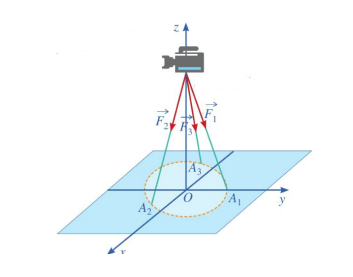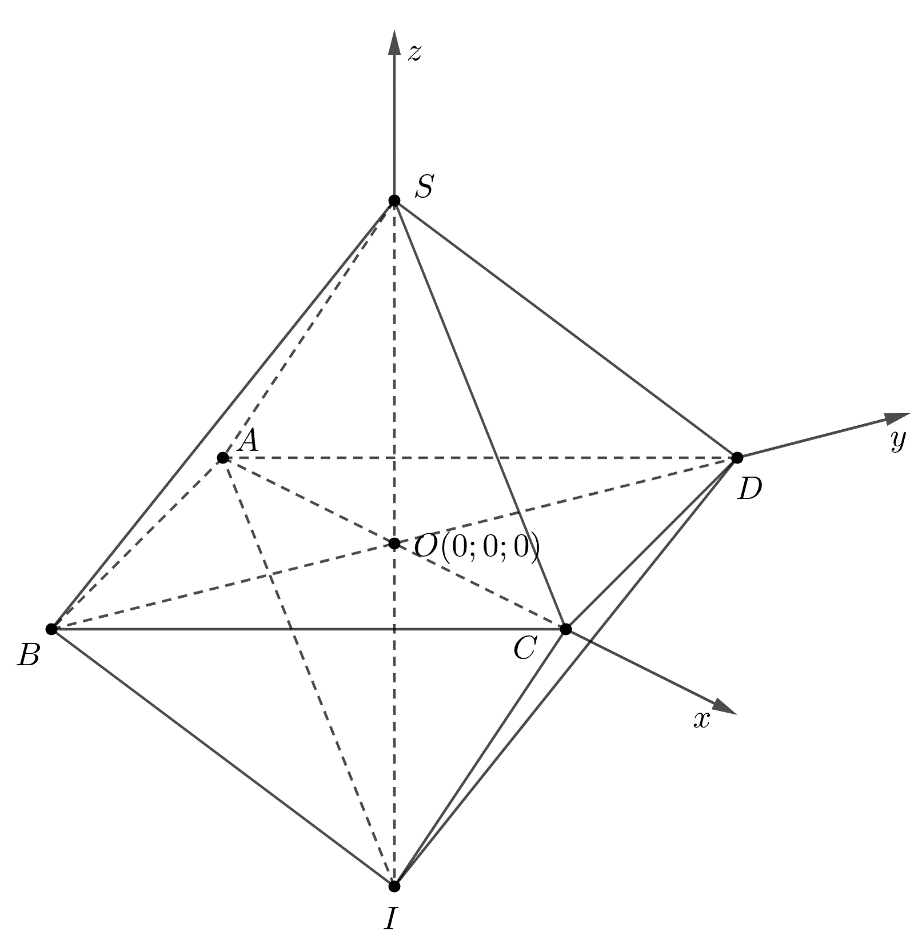Cho hai điểm \(A\left( {1\,;\,2\,;\,3} \right)\) và \(B\left( {3\,;\,0\,;\, - 5} \right)\). Gọi \(M\) là điểm đối xứng của \(A\) qua \(B\). Tọa độ của điểm \(M\) là:
Câu hỏi trong đề: Đề kiểm tra Ôn tập cuối chương 2 (có lời giải) !!
Quảng cáo
Trả lời:
Vì \(M\) là điểm đối xứng của \(A\) qua \(B\) nên \(B\) là trung điểm của \(AM\).
Gọi \(M\left( {{x_M}\,;\,{y_M}\,;\,{z_M}} \right)\), ta có
\(\left\{ {\begin{array}{*{20}{c}}{{x_B} = \frac{{{x_A} + {x_M}}}{2}}\\{{y_B} = \frac{{{y_A} + {y_M}}}{2}}\\{{z_B} = \frac{{{z_A} + {z_M}}}{2}}\end{array}} \right.\) \( \Leftrightarrow \left\{ {\begin{array}{*{20}{c}}{{x_M} = 2{x_B} - {x_A}}\\{{y_M} = 2{y_B} - {y_A}}\\{{z_M} = 2{z_b} - {z_A}}\end{array}} \right.\) \( \Leftrightarrow \left\{ {\begin{array}{*{20}{c}}{{x_M} = 2.3 - 1 = 5\,\,\,\,\,\,\,\,\,\,\,\,\,\,\,}\\{{y_M} = 2.0 - 2 = - 2\,\,\,\,\,\,\,\,\,\,\,\,}\\{{z_M} = 2.\left( { - 5} \right) - 3 = - 13\,\,}\end{array}} \right.\)
Vậy \(M\left( {5\,;\, - 2\,;\, - 13} \right)\).
Hot: 1000+ Đề thi cuối kì 1 file word cấu trúc mới 2025 Toán, Văn, Anh... lớp 1-12 (chỉ từ 60k). Tải ngay
- 500 Bài tập tổng ôn môn Toán (Form 2025) ( 38.500₫ )
- 20 Bộ đề, Tổng ôn, sổ tay môn Toán (có đáp án chi tiết) ( 55.000₫ )
- Sổ tay lớp 12 các môn Toán, Lí, Hóa, Văn, Sử, Địa, KTPL (chương trình mới) ( 36.000₫ )
- Bộ đề thi tốt nghiệp 2025 các môn Toán, Lí, Hóa, Văn, Anh, Sinh, Sử, Địa, KTPL (có đáp án chi tiết) ( 36.000₫ )
CÂU HỎI HOT CÙNG CHỦ ĐỀ
Lời giải
a) Đúng.
b) Đúng.
Ta có: \(\overrightarrow {C'K} = \overrightarrow {C'C} + \overrightarrow {CK} = \overrightarrow {C'C} + \frac{1}{2}\left( {\overrightarrow {CA} + \overrightarrow {CD} } \right) = \overrightarrow {C'C} + \frac{1}{2}\left( {\overrightarrow {C'A'} + \overrightarrow {C'D'} } \right)\)
\( = \overrightarrow {C'C} + \frac{1}{2}\left( {\overrightarrow {C'B'} + \overrightarrow {C'D'} + \overrightarrow {C'D'} } \right) = \overrightarrow {C'C} + \frac{1}{2}\overrightarrow {C'B'} + \overrightarrow {C'D'} \)
c) Sai.
Ta có: \[\overrightarrow {AB} .\overrightarrow {B'D'} = \left( {\overrightarrow {AA'} + \overrightarrow {A'B'} + \overrightarrow {B'B} } \right).\overrightarrow {B'D'} = \overrightarrow {AA'} .\overrightarrow {B'D'} + \overrightarrow {A'B'} .\overrightarrow {B'D'} + \overrightarrow {B'B} .\overrightarrow {B'D'} = \overrightarrow {A'B'} .\overrightarrow {B'D'} \]
\( = A'B'.B'D'.{\rm{cos}}\left( {\overrightarrow {A'B'} ,\overrightarrow {B'D'} } \right) = a.a\sqrt 2 .{\rm{cos}}\left( {135^\circ } \right) = - {a^2}\)
d) Đúng.
Ta đặt \[\overrightarrow {AA'} = \overrightarrow a ,\overrightarrow {AB} = \overrightarrow b ,\overrightarrow {AD} = \overrightarrow c \]. Ta có \[\left| {\overrightarrow a } \right| = \left| {\overrightarrow b } \right| = \left| {\overrightarrow c } \right| = a\]
\[\overrightarrow {AC'} = \overrightarrow {AA'} + \overrightarrow {AB} + \overrightarrow {AD} \] hay \[\overrightarrow {AC'} = \overrightarrow a + \overrightarrow b + \overrightarrow c \]
Mặt khác
\[\overrightarrow {MN} = \overrightarrow {AN} - \overrightarrow {AM} = \left( {\overrightarrow {AB} + \overrightarrow {BN} } \right) - \left( {\overrightarrow {AD} + \overrightarrow {DM} } \right)\] với \[\overrightarrow {BN} = \frac{x}{a}.\overrightarrow a \] và \[\overrightarrow {DM} = \frac{x}{a}.\overrightarrow b \]
Do đó \[\overrightarrow {MN} = \left( {\overrightarrow b + \frac{x}{a}\overrightarrow a } \right) - \left( {\overrightarrow c + \frac{x}{a}\overrightarrow b } \right) = \frac{x}{a}\overrightarrow a + \left( {a - \frac{x}{a}} \right)\overrightarrow b - \overrightarrow c \]
Ta có \[\overrightarrow {AC'} .\overrightarrow {MN} = \left( {\overrightarrow a + \overrightarrow b + \overrightarrow c } \right)\left[ {\frac{x}{a}\overrightarrow a + \left( {a - \frac{x}{a}} \right)\overrightarrow b - \overrightarrow c } \right]\]
Vì \[\overrightarrow a .\overrightarrow b = 0,\overrightarrow a .\overrightarrow c = 0,\overrightarrow b .\overrightarrow c = 0\] nên ta có
\[\overrightarrow {AC'} .\overrightarrow {MN} = \frac{x}{a}{\overrightarrow a ^2} + \left( {1 - \frac{x}{a}} \right){\overrightarrow b ^2} - {\overrightarrow c ^2} = x.a + \left( {1 - \frac{x}{a}} \right){a^2} - {a^2} = 0\], vậy góc giữa vectơ \[\overrightarrow {AC'} \] và \(\overrightarrow {MN} \) bằng \(90^\circ \).
Câu 2
Lời giải
Ta có: \(\overrightarrow {E{A_1}} = \left( {0;1; - 8} \right)\),\(\overrightarrow {E{A_2}} = \left( {\frac{{\sqrt 3 }}{2};\frac{{ - 1}}{2}; - 8} \right)\), \(\overrightarrow {E{A_3}} = \left( {\frac{{ - \sqrt 3 }}{2};\frac{{ - 1}}{2}; - 8} \right)\) Nên \(E{A_1} = E{A_2} = E{A_3} = \sqrt {65} \)
Mặt khác, \(\left| {\overrightarrow {{F_1}} } \right| = \left| {\overrightarrow {{F_2}} } \right| = \left| {\overrightarrow {{F_3}} } \right|\) vì đèn cân bằng và trọng lực của đèn tác dụng đều lên 3 chân của giá đỡ
Do đó : \(\overrightarrow {{F_1}} = k\overrightarrow {E{A_1}} = \left( {0;k; - 8k} \right)\),\[\overrightarrow {{F_2}} = k\overrightarrow {E{A_2}} = \left( {\frac{{\sqrt 3 }}{2}k;\frac{{ - 1}}{2}k; - 8k} \right)\],\(\overrightarrow {{F_3}} = k\overrightarrow {E{A_3}} = \left( {\frac{{ - \sqrt 3 }}{2}k;\frac{{ - 1}}{2}k; - 8k} \right)\)
\( \Rightarrow {\overrightarrow F _1} + \overrightarrow {{F_2}} + {\overrightarrow F _3} = \left( {0;0; - 24k} \right)\)
Mà \({\overrightarrow F _1} + \overrightarrow {{F_2}} + {\overrightarrow F _3} = \overrightarrow P = \left( {0;0; - 240} \right) \Rightarrow - 24k = - 240 \Rightarrow k = 10\)
Vậy \(\overrightarrow {{F_1}} = \left( {0;10; - 80} \right)\)
Lời giải
Bạn cần đăng ký gói VIP ( giá chỉ từ 199K ) để làm bài, xem đáp án và lời giải chi tiết không giới hạn.
Lời giải
Bạn cần đăng ký gói VIP ( giá chỉ từ 199K ) để làm bài, xem đáp án và lời giải chi tiết không giới hạn.
Lời giải
Bạn cần đăng ký gói VIP ( giá chỉ từ 199K ) để làm bài, xem đáp án và lời giải chi tiết không giới hạn.
Lời giải
Bạn cần đăng ký gói VIP ( giá chỉ từ 199K ) để làm bài, xem đáp án và lời giải chi tiết không giới hạn.
Lời giải
Bạn cần đăng ký gói VIP ( giá chỉ từ 199K ) để làm bài, xem đáp án và lời giải chi tiết không giới hạn.

